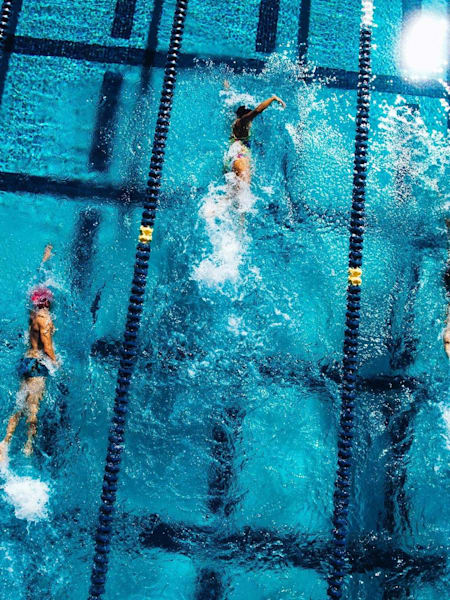Fitness
Swimming is a very satisfying form of exercise. As well as giving you a low-resistance, full body workout, you can instantly start to see benefits of your sessions in the pool – everything starts to be that bit easier with each visit, and you’ll be able to swim distances you previously wouldn’t have even thought possible.
But what happens when your progress starts to plateau? Fortunately, former World and Commonwealth Champion Katy Sexton MBE has some tips. Now a personal trainer and swimming coach, she has recommended the following gym exercises to take your swimming to the big leagues.
1. Squat jumps
The first exercise I’d recommend is the squat jump. These can either be achieved with purely bodyweight or they can be weighted by holding dumbbells or a barbell. They will work your quads, glutes and calf muscles, helping you to explode off the starting blocks and the walls after a tumble turn.
Reps: 12
Sets: 3
2. Tricep extension
Although smaller in stature than the bicep, the tricep is an important arm muscle that is used in all strokes. While seated, take a dumbbell in each hand and put your hands behind your head – your elbows should be in line with your back and pointing upwards. Extend the weight above your head, hold and bring back down to your starting position in a smooth motion. The tricep will fatigue quite quickly, but fortunately it makes a speedy recovery, too.
Reps: 12-15
Sets: 3
3. Deadlift
The deadlift is quite a hard exercise to master. It works your lower posterior chain – lower back, glutes and hamstrings – and will give you leg strength and a better body position in the water. When it comes to weight, you want something that will leave you feeling fatigued towards the end of a set. Once you start feeling comfortable, gradually increase the weight.
Reps: 8-10
Sets: 3-5
4. Hanging crunch
Although a lot of people hate it, the hanging crunch is one of my favourite exercises. Hold on to a pull-up bar with your hands and leave your body hanging. Lift your knees up to your chest and return down to a straight-leg position.
Hanging crunches help with all strokes because it works the core. Strengthening the core is key because it enables you to support your legs at a higher position in the water – giving you a better position and less resistance in the pool.
Holding your body as still as possible is key when doing a hanging crunch. Initially, there might be a tendency for your body to swing because you haven’t got the control there.
Rep: 30 seconds
Sets: 3
Break between sets: 30 seconds
5. Overhead squat
Overhead squats help with your glutes and quads, which will help with your kick, starts and turns in the pool. Also, as you keep your arms above your head throughout, you’re forced to control the core’s stability and your arms a bit more – helping with streamlining when you push off the wall and generally improving your position in the water.
Keep your feet at a slightly wider stance than with a normal squat. Also, if you’ve never performed an overhead squat before, start off using just a stick until you get the technique right. Once mastered, build up the weight using dumbbells, barbells or a medicine ball – whatever suits best.
Reps: 12
Sets: 3
6. Kneeling Supermans
In the pool, you’re having to use opposing sides of your body in tandem – if doing front crawl or backstroke, your left arm would work with your right leg and vice versa. Kneeling supermans help get you used to this multitasking; most people really notice that they have one side weaker than the other.
On all fours, extend your right arm forward while extending your left leg back. Hold the position for a few seconds before repeating with your other side. The exercise works your upper and lower back, abs and glutes, and again strengthens the core.
Reps: 10 of 3 seconds on each side
Sets: 3
7. Shoulder rotations with resistance bands
These are key for for shoulder stability and injury prevention. There’s a lot of repetition on your shoulders in the pool and this exercise gets the stability muscles around the shoulders working – taking some of the pressure off the bigger ones essential in all strokes.
Wrap a resistance band around a banister or door, have your elbow bent at a right angle and rotate the arm out. Repeat with your other arm before switching and rotating the arm in.
Shoulder rotations are an exercise that should be done little and often – once or twice a week. I’d recommend doing them before getting into the pool for a swim, or even incorporate them as part of a warm up before lifting any weights.
Reps: 12-16
Sets: 2-3
8. Pull ups
These work your latissimus dorsi – that long, thin muscle in your back that runs from your armpits to your pelvis, and otherwise known as “lats”. Strengthening your lats will really help with pull phase of all the strokes.
I recommend an overhand grip, but some might prefer to do it with a palm-facing grip. Also, the wider your arms, the harder it is too. If you can’t do an unassisted pull ups, start your first set with assistance that is almost equal to bodyweight, and try and reduce assistance as you go through each set.
Reps: Do as a pyramid – start at 12 and reduce by 2 reps with each set.
Sets: 5









